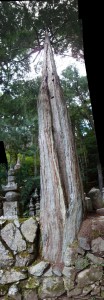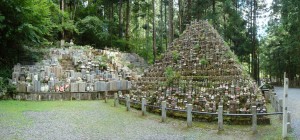The thing that disappoints me most about my difficulty in making it to the top of Fujisan is that we deliberately came in August in order to do so – the official climbing season closes at the end of August, and along with it, all of the mountain huts will be closing too. The thing is, August is the hottest month of the year in Japan. It’s not the wettest, fortunately (that fate is reserved for June) but it’s still unpleasantly humid. It’s rare that we have a day any cooler than 33°C, and humidity is typically well over 50%. Still, however, the Japanese go about their business, albeit many of them with a towel around their neck or shoulder or discreetly hidden in a purse, with which to wipe the sweat from their faces. I’ve got one too. What a hoopy frood I am. Still, next time we come when it’s cooler.
So, Osaka. Our original plan for our three days in Osaka was to spend them not in Osaka – we had one day in Kyoto, one in Nara, and one in Koya-san, a small town to the South. Later we revised our plan to spend two days in Kyoto later in the trip, giving us a free day to actually spend inside Osaka. We used that day today to visit both the old – Osaka Castle – and the new – Osaka Aquarium.
Catching trains in Osaka is a bit of a different experience to catching them in Tokyo. Even on the JR lines, things are signposted differently, electric displays are often not translated to English, and different train lines are generally indicated by destination rather than by name or colour code. In Tokyo, finding the right platform was a matter of going “ok, I want the Yokohama line, that’s lime green, now let’s just follow all the lime green signs”. Here it’s more like “I want to get to Osakajokitazume station, that’s in the direction of Kyobashi, so I need to follow the signs to Kyobashi.” Today we also had the added experience of catching private railway line trains. Since our JR passes won’t work for them, we had to buy tickets – pricing is a matter of finding your destination on the current station’s map, and reading off the price. On the plus side, the private line stations are all identified by a code with a letter signifying which line, and a number signifying which station on that line it was. So C15 would be the 15th station on the Chuo line, C16 would be the next station in one direction, C14 the next station in the other. Finding the right platform, then, was a matter of finding a train that terminated on the same line with a number either higher (if you were heading up-line) or lower (for down-line) than the station you were currently at.
Whew. So, Osaka Castle. Getting there was interesting, because we had to change between two of the JR lines that didn’t actually stop at the same station – the next station was a ten-minute walk down an underground tunnel then shopping arcade. This lead us to our first subway station in Japan. As we discovered, all the subway stations are decorated with the same ugly pattern of beige tiles that does weird things to your eyes, and often are comprised largely of incredibly long non-air-conditioned pedestrian tunnels to get from platform to platform and to the exits. And the “subway” lines occasionally change from being underground to being elevated above the ground. The private line subways run in a sort of grid pattern through the cities, meaning interchange stations generally have two platforms at right angles to each other. One station we passed through today was at the intersection of three lines, with three platforms arranged in a huge U-shape, twenty-eight street exits, and three different station codes; one for each line – Y13, C16 and M18.
Anyway, Osaka Castle. We eventually got there without a hitch. It looks quite impressive from a distance – white walls and shiny golden bits. The outer fortifications are imposing and quite amazing. Trouble is, the closer I got, the more it looked to me like the place needed some maintenance – the moats were filled with green (and occasionally red) algae, plants were growing out of the walls, and some places even had graffiti. More than that, as I started to get really close, the castle itself started to look gaudy and tacky. Huge banks of floodlights to light it up at night. An elevator so disabled people could reach the entrance. Even until we reached the door, I was still expecting something at least similar to Matsumoto Castle.
When I entered the door, however, I was greeted by a blast of cold, air-conditioned air, and a broad expanse of granite and marble. Not to mention two attendants inviting me into the lift that’d take me to near the top floor. Granted, the view from the top was impressive, but it wasn’t a castle, just a museum. Every level had displays about the history of the castle – mostly about a specific battle in the summer of 1615, when the Shogun, Tokugawa Ieyasu, defeated the Toyotomi clan who were controlling the castle. It was fairly interesting, but not really breath-taking, or at all what I was expecting. Apparently the previous castle was destroyed in the Second World War – this was a concrete reconstruction completed in 1997. A little disappointed, James and I headed off to the aquarium.
On an amusing side note, we were sitting having a break on the top floor of the castle, and a twenty-something boyfriend and girlfriend came over. He indicated by guestures and a bit of English that he wanted us to help him with a photo. Not for us to take a photo of the two of them, no – he wanted a photo of us. A little bemused, we agreed, posed for the photo, and then he thanked us, shook hands, and headed off. (I have, though, noticed a few more Westerners in Osaka than I really saw in Tokyo, though we did spot a few, especially on/near Fuji, the Ghibli museum, and on the shinkansen platforms.)
Osaka Aquarium is in a part of the city’s ports district called Tempozan. It’s basically Osaka’s equivalent of Sydney’s Darling Harbour, complete with IMAX cinema. There’s also a huge ferris wheel – it claims to be the largest in the world, but it only held that title until 1999. Currently it’s not even the largest in Japan, never mind the rest of the world. It was still pretty impressive. After a lunch of sushi and some other rice-parcel things from a convenience store, we had a ride on it. James was unenthused, but I enjoyed it. Then we headed to the aquarium atself, and that was seriously impressive. The aquarium is housed in a huge eight-storey building, and contains many massive tanks passing through several storeys, with each tank representing a different habitat – Japan Forest, Great Barrier Reef, Antarctica, et cetera – and a six hundred metre long ramped path winding its way between them. The biggest tank, the Pacific Ocean tank, runs down the centre of the building from the fourth floor to the sixth, and contains a whale shark, a manta ray, and a large number of other fish. James was a shade nonplussed as the time we’d spent on the Ferris wheel meant we’d just missed both the otter feeding and the dolphin feeding, but both animals were still feeling plenty playful – the otters were running around chasing each other and pouncing on the hose an attendant was using to clean the enclosure, while the dolphins were swimming all over.
The aquarium was filled with small screaming children, though, and you can imagine what that’s like standing in a hallway surrounded on two sides by thirty-centimetre-thick plexiglass. I was starting to develop a headache by the time we were through. On the plus side, we encountered an ultra-violet light at one point – I’d always wanted to look at my passport under ultra-voilet, because the front page claims there’s a security feature that only shows up under ultra-voilet. In fact, the whole passport turned into this glowy, fluorescent thing – not only the security feature, but the background images on all the pages glowed quite brightly, and the cover was covered (hah) in little red stamps saying “AUS”. It was really quite pretty. =)
We managed to head back to our hotel during rush hour, but it wasn’t too bad. I am starting to worry a shade about what I’m going to get for souvenirs, though. It’s gotta be something I can fit in for the trip home. Anyway, dinner was udon. Unable to read the menu again, we went for the good old fall-back and pointed to one of the few things on it that had an image. We’ve really gotta work this out better. Apparently, Osaka’s speciality is okonomiyaki (sort of Japanese pizza, but not quite) – we’ll try that one of the next two days if we find ourselves in the right place at dinner time. If all else fails, it’s also a speciality in Hiroshima, where we’ll be next, though they have a slightly different style for it there.
Tomorrow is Koya-san, an hour or so to the south. It’s apparently the home of Buddhism in Japan, and has some pretty impressive-looking temples there, including Oku-no-In, the cemetery-temple where everyone who’s anyone gets buried in the hopes of advancing themselves up the waiting list for the afterlife.
Today’s photo count: two hundred and thirty six. I didn’t really feel like taking photos inside Osaka Castle, and it wasn’t really going to work at the aquarium.
20100827 [ngg_gallery=9]









